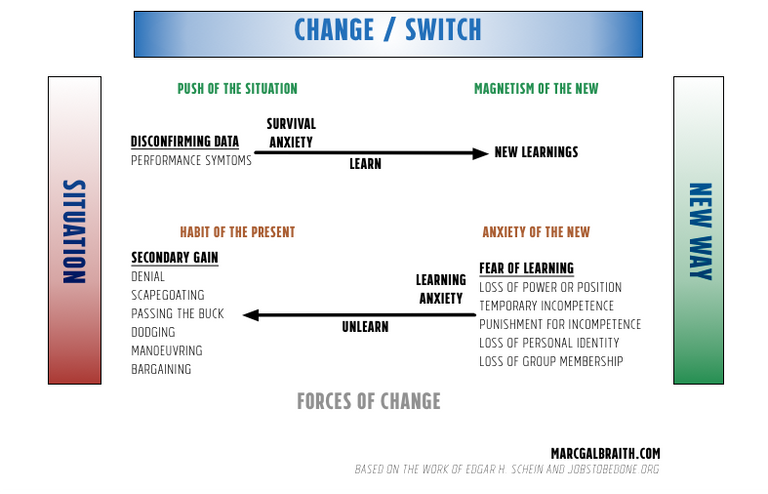Dynamics of Change
Edgar H. Schein in his book Organizational Culture and Leadership, discusses the general stages of change within human systems such as groups and organisations, drawing from his consulting and research. Kurt Lewin wrote an article back in 1947 and concluded that for people and group performance to change there appears to be three stages that they go through to establish new levels of performance:
- Unfreezing the current level.
- Moving to the new level.
- Freezing the new level.
Edgar augmented this in the following manner (page 299):
- Unfreezing: Creating the motivation to change.
- Learning new concepts, new meanings for old concepts and new standards for judgement.
- Internalising new concepts, meanings and standards.
While reflecting on these observations I started to think about the application of jobs-to-be-done theory, in particular the concept of progress making forces. It led me to ponder that the observations of people change and customer switching are closely related for they have one thing in common, being involved in a situation; the realisation that there is a problem causing motivation to be established. When a person decides to stop doing one thing and start doing another we call this a Switch in jobs-to-be-done language. Combining this thinking with Lewin/Edgar’s stages of change caused me to think that a customer appears to go through three distinct stages within a Switch:
- New situation arises in their life.
- Work towards resolving it, leveraging products and services
- Establish a new way.
To navigate these stages we think of it within jobs-to-be-done as a set of forces. They can be broken into 4 distinct areas and have an impact on each other:
- Push of the situation.
- Attraction of the new.
- Anxiety of the new.
- Habit of the present.
Forces 1 and 2 are progress generating (pushing forward) whilst 3 and 4 are resistive in nature (pulling back). Edgar Schein groups these forces in anxiety terms:
- Survival Anxiety - Must do something, learn what it is.
- Learning Anxiety - Unlearning something so it can be learned.
My perception is that the progress generating forces in a Switch are the same components we can find in Survival Anxiety. In that for a person (customer) to survive they must actually learn something and likewise the resistive forces are akin to Learning Anxiety; the confrontation that a person will have to unlearn something. In social or group settings this threat is quite alarming. It’s easy to learn new things when there is no unlearning and explains why it is easier when we are younger to learn as we simply have nothing to unlearn! We tend to find it hard to give up present habits, for those very habits are learned and must be unlearned if we are to make the Switch. Unlearning can generate a complex set of emotions which can cause all sorts of defence mechanisms to kick in.
When studying the four forces through the perspective of jobs-to-be-done we learn that the progress generating forces always come with a side-effect; the more you focus on them the more resistive forces you potentially generate. It is as if you are stretching the customer further and further away from their old habits that has them unconsciously more and more concerned. Edgar Schein describes the same relationship between Survival and Learning Anxiety, outling two principles for transformative change aka Switching:
Principles
- Survival anxiety (progress making forces) or guilt must be greater than learning anxiety.
- Learning anxiety (resistive forces) must be reduced rather than increasing survival anxiety.
I believe these schools of thought overlap and blend nicely so I have created a hybrid diagram displaying the dynamics of change for a person which in turn is a customer. 